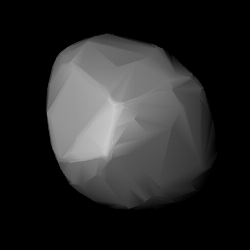 Modelled shape of Mechthild from its lightcurve | |
| Discovery [1] | |
|---|---|
| Discovered by | M. F. Wolf |
| Discovery site | Heidelberg Obs. |
| Discovery date | 21 May 1917 |
| Designations | |
| (873) Mechthild | |
Named after | unknown [2] |
| A917 KJ ·1917 CA | |
| Orbital characteristics [3] | |
| Epoch 31 May 2020 (JD 2459000.5) | |
| Uncertainty parameter 0 | |
| Observation arc | 102.24 yr (37,343 d) |
| Aphelion | 3.0199 AU |
| Perihelion | 2.2346 AU |
| 2.6273 AU | |
| Eccentricity | 0.1495 |
| 4.26 yr (1,555 d) | |
| 48.264° | |
| 0° 13m 53.04s / day | |
| Inclination | 5.2763° |
| 150.00° | |
| 109.99° | |
| Physical characteristics | |
| 11.006±0.001 h [9] | |
Pole ecliptic latitude | |
| 11.4 [1] [3] | |
873 Mechthild (prov. designation: A917 KJor1917 CA) is a dark background asteroid from the central regions of the asteroid belt. It was discovered by German astronomer Max Wolf at the Heidelberg Observatory on 21 May 1917. [1] The primitive P-type asteroid has a rotation period of 11.0 hours and measures approximately 34 kilometers (21 miles) in diameter. The origin of the asteroid's name remains unknown. [2]